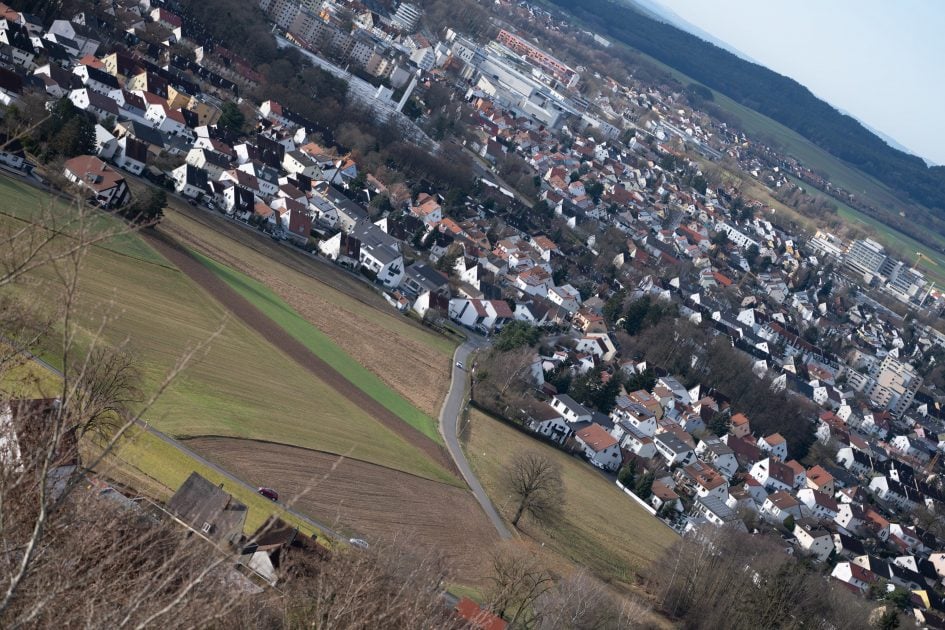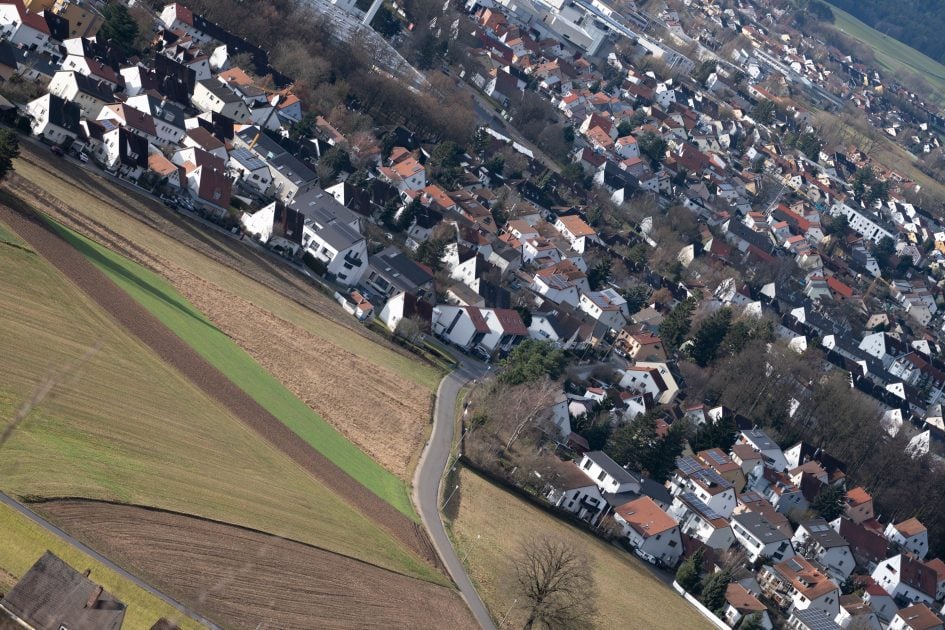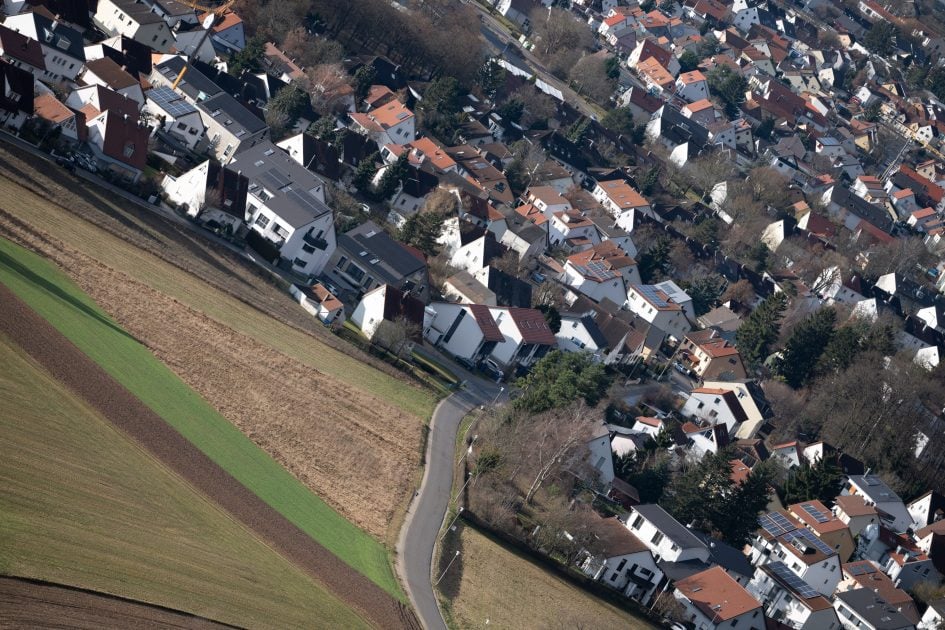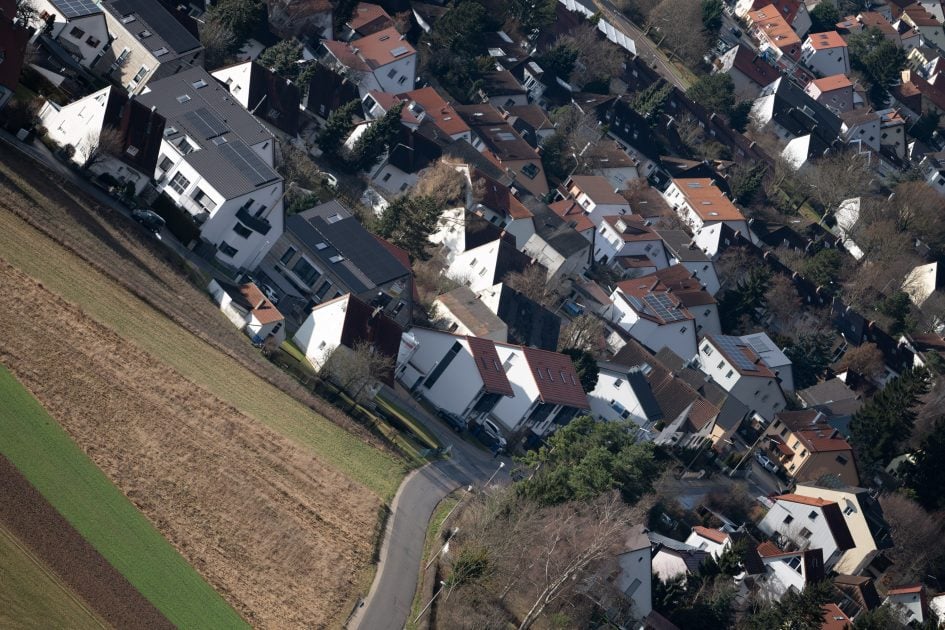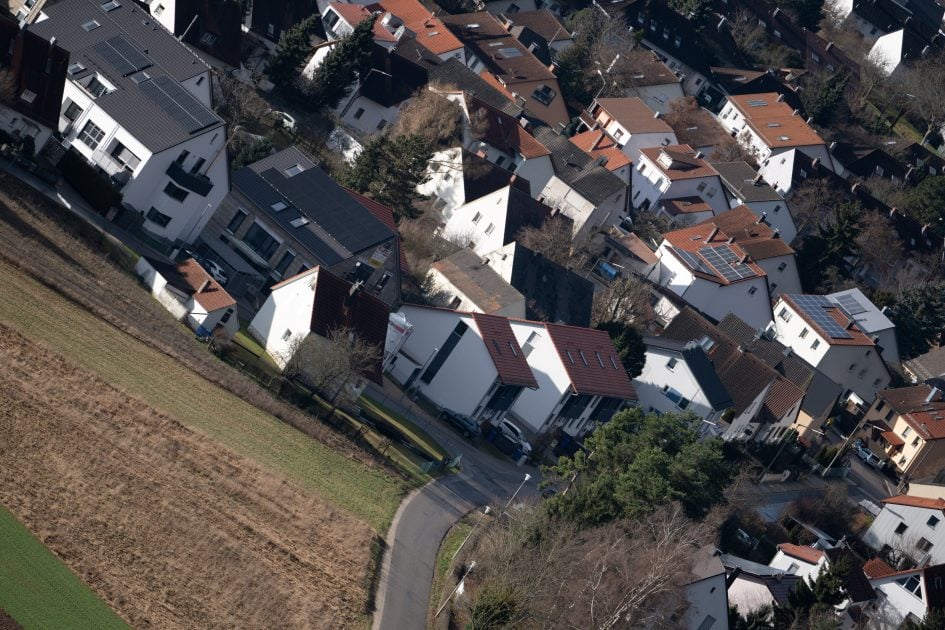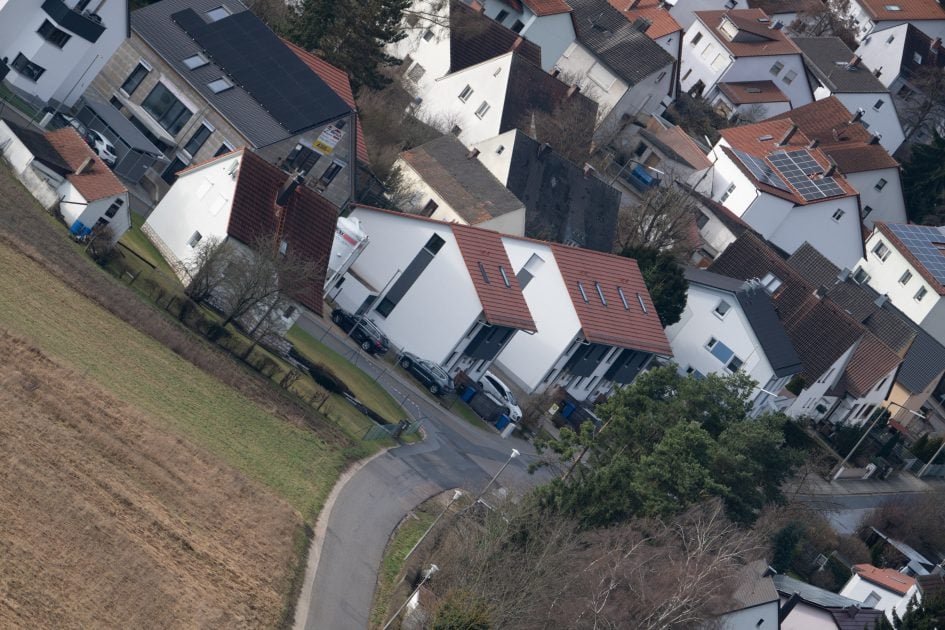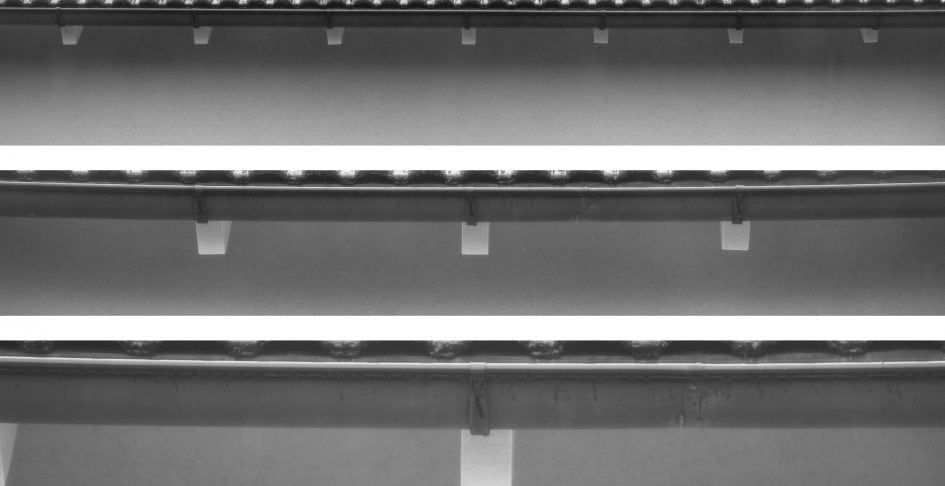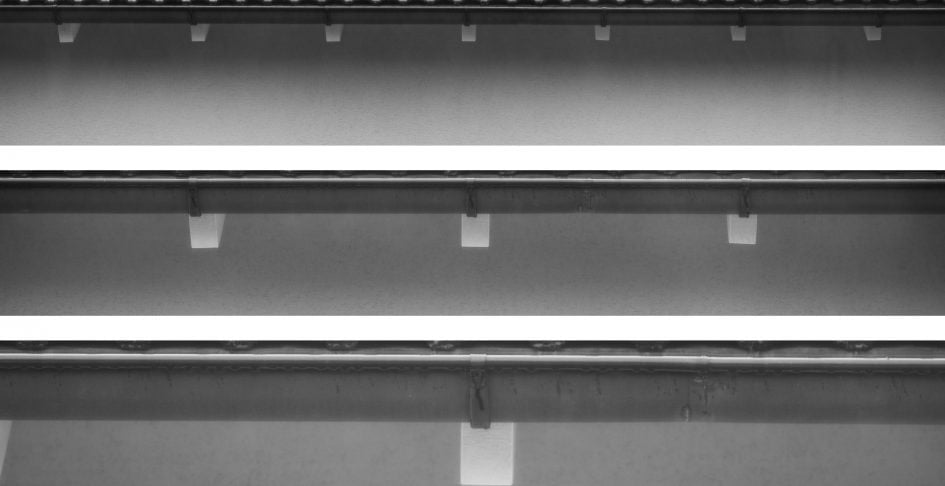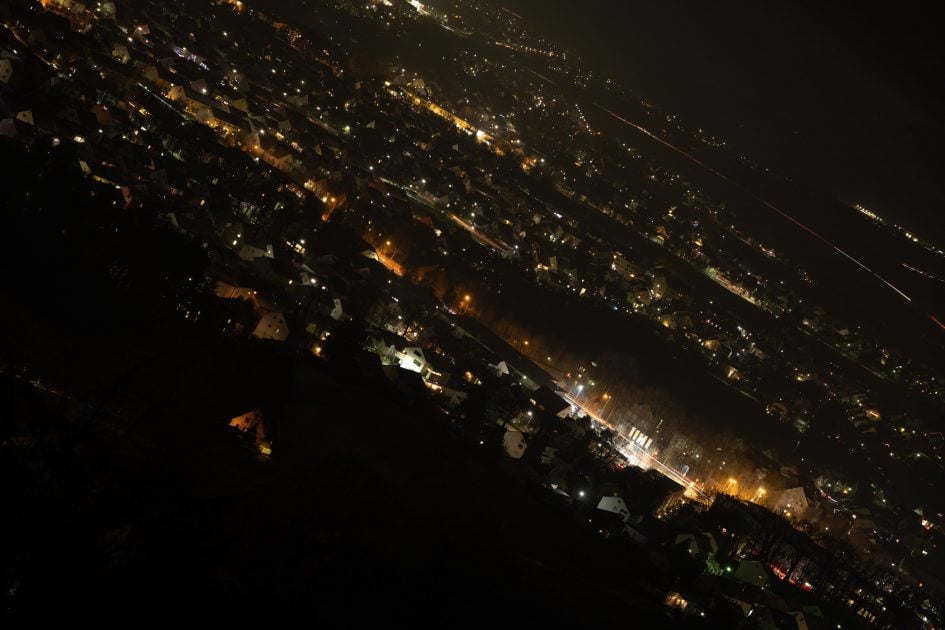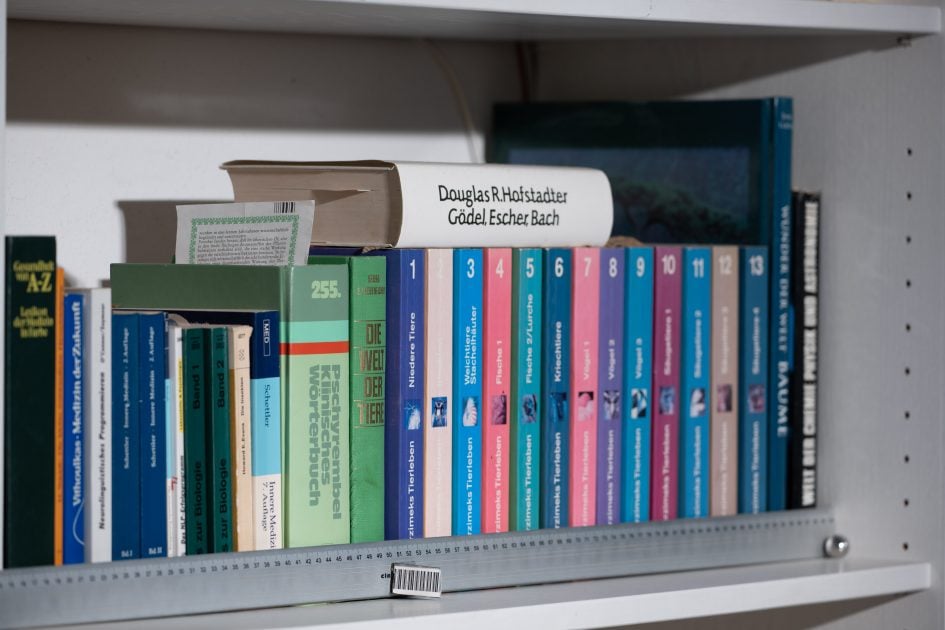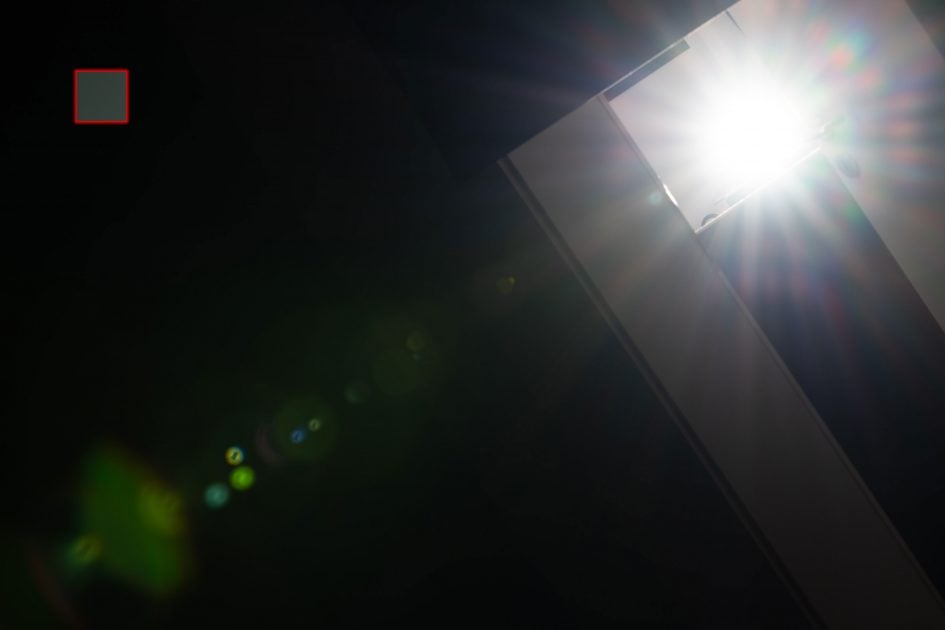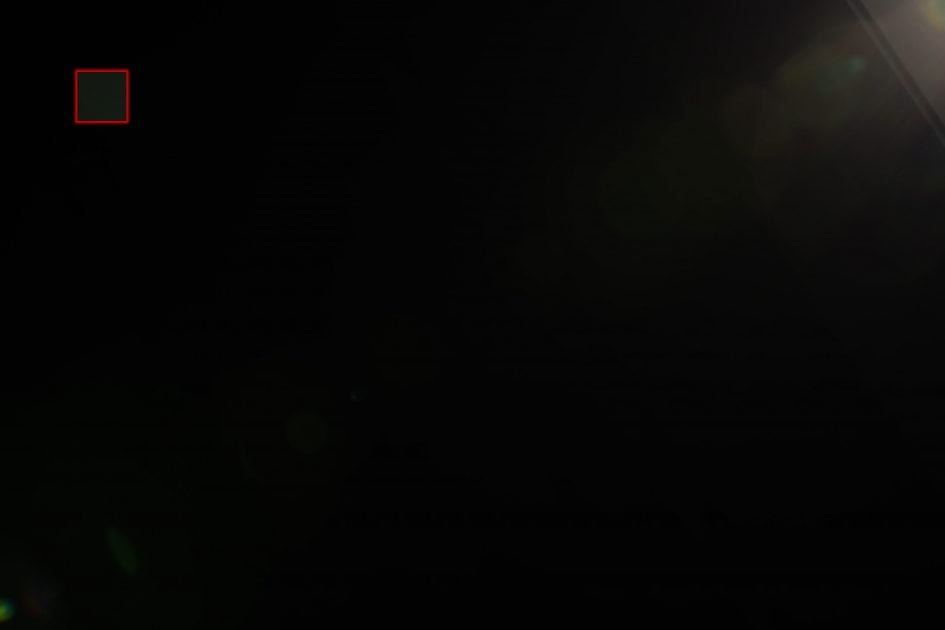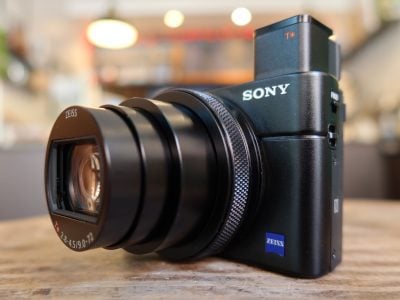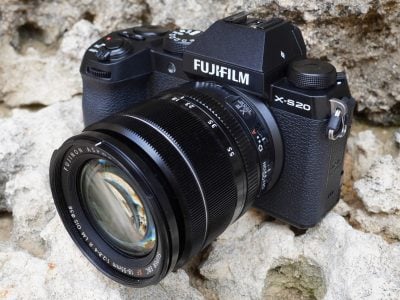Nikon Z 100-400mm f4.5-5.6 review
-
-
Written by Thomas
Quality
Longitudinal Chromatic Aberration and focus shift
Although the Nikon Z 100-400mm f4.5-5.6 VR S has a focal ratio of only f4.5 at the short end I tested for longitudinal color aberrations (loCA, a.k.a. “axial color” or “bokeh CA”). These show up as magenta coloration in the foreground and greenish hues in the background and are not easily corrected in post-processing. The new Z-Nikkor has almost no loCA. There’s a slight trace of focus shift towards the foreground – which becomes sharper faster than the background.
Nikon Z 100-400mm f4.5-5.6 VR S longitudinal Chromatic Aberration (loCA)
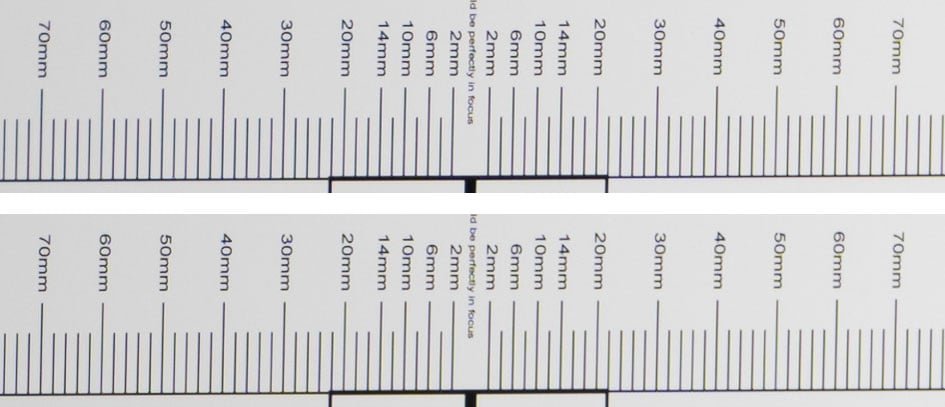
100% crops at 260mm f5.0 (top), f8.0 (bottom); 100% crops, left = foreground, right = background
The following shot shows that the Nikon Z 100-400mm f4.5-5.6 VR S produces just a tiny bit of purple fringing around high-contrast edges in the focus plane and only minimal green outlining around background subjects:
Above: Nikon Z 100-400mm f4.5-5.6 VR S at 185mm f5.6; 100% crop, click image for 4k version, here for large original
Sharpness and contrast
Let’s have a look at the theoretical performance of the Nikon Z 100-400mm f4.5-5.6 VR S, Nikon AF-S 80-400mm f4.5-5.6G ED VR and Nikon Z 70-200mm f2.8 VR S:
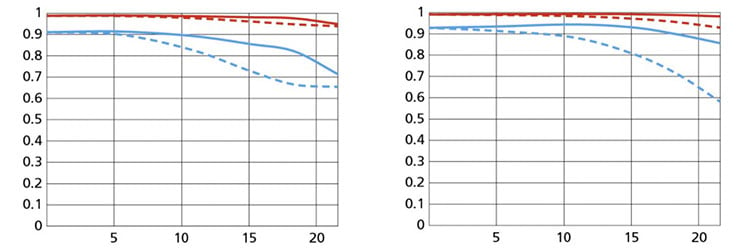
Above: Nikon Z 100-400mm f4.5-5.6 VR S at 100mm f4.5 (left), 400mm f5.6 (right)
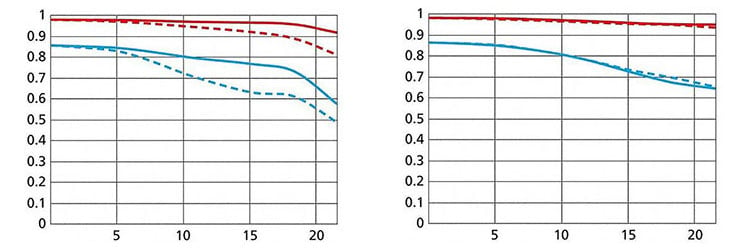
Above: Nikon AF-S 80-400mm f4.5-5.6G ED VR at 80mm f4.5 (left), 400mm f5.6 (right)
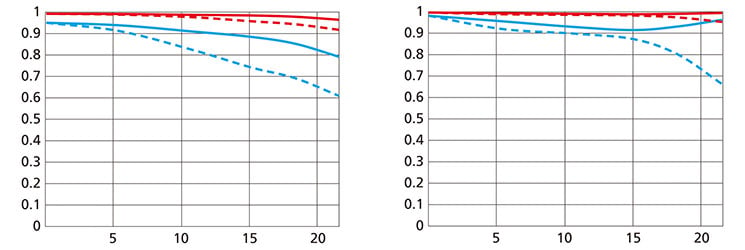
Above: Nikon Z 70-200mm f2.8 VR S at 70mm f2.8 (left), 200mm f2.8 (right)
These MTF charts show the computed lens-performance of lenses wide open at infinity without influence of diffraction at 10 line-pairs/mm (red) and 30 lp/mm (blue/green). Higher values are better (more contrast) and the closer the dotted and solid lines are together the less contrast dependents on the orientation of the test-pattern (less astigmatism). The x-axis displays the distance from the optical axis (=center of the sensor) in mm.
From the charts the new Z 100-400mm f4.5-5.6 VR S should be clearly sharper than its predecessor. The Nikon Z 70-200mm f2.8 VR S looks even better (without teleconverters) although it is shown here at f2.8 – a disadvantage of 1.3-2 stops.
Let’s see how this theoretical performance translates into real life results in the sharpness test based on Siemens-stars shot on a 45MP Nikon Z7. Processing for all images up to 200mm focal length was done in Lightroom 11.1/CRAW 14.1 from RAW to Adobe Color profile with the built-in lens profile for CA, vignette control and distortion compensation applied. Noise-reduction is set to 0, sharpening to 50/0.5/36/10, with no extra tone, color, or saturation adjustment. The images at focal lengths of 300mm and longer (except for the Z 70-200 + TC-2.0x) were shot in JPG normal with standard picture control which applies a stronger sharpening. It’s not my preferred settings but it will have to do for this comparison. White-balance was adjusted to a neutral white and I did some exposure compensation to make the brightness of all crops match. So you will not see light fall-off in the corners.
The following are all 100% crops!
First up is an overview of the wide-open performance at different focal lengths – including 560mm shot with the Nikon Z TC-1.4x. You can jump to the detailed results at different apertures and comparisons with other lenses by clicking on the crops of the respective focal length.
Nikon Z 100-400mm f4.5-5.6 VR S; 100% crop from center, DX-corner, FX-corner
Above: 100mm, f4.5
Above: 150mm, f4.8
Above: 200mm, f5.0
Above: 300mm, f5.3
Above: 400mm, f5.6
Above: 560mm, f8.0 (with TC-1.4x)
Nikon’s new zoom lens looks very sharp across the full-frame sensor throughout the zoom-range with only a slight softening towards the FX-corner. Even using the TC-1.4x results in very respectable performance at 560mm focal length. The lens also exhibits only very little field curvature over its zoom range. Very good!
The following 100% crops for each focal length show the Nikon Z 100-400mm f4.5-5.6 VR S from wide open down to f11 compared to the Nikon AF-S 80-400mm f4.5-5.6G ED VR and Nikon Z 70-200mm f2.8 VR S + TC-2.0x. I also added the combination of Nikon Z 100-400mm f4.5-5.6 VR S with TC-1.4x to judge how good performance holds up when using the combo at shorter focal lengths,
If you want to see all the details and comparisons read on. Or you can fast-forward to the performance at long distances.
Performance at 100mm:
Nikon Z 100-400mm f4.5-5.6 VR S at 100mm compared; 100% crop from center, DX-corner, FX-corner

Above: Nikon Z 100-400mm f4.5-5.6 VR S at 100mm, f4.5

Above: Nikon AF-S 80-400mm f4.5-5.6G ED VR at 105mm, f4.8; also available at f5.6, f8.0, f11

Above: Nikon Z 100-400mm f4.5-5.6 VR S at 100mm, f5.6; also available at f8.0, f11
At 100mm the Nikon Z 100-400mm f4.5-5.6 VR S is sharper than the F-Nikkor outside the center.
Performance at 150mm:
Nikon Z 100-400mm f4.5-5.6 VR S at 150mm compared; 100% crop from center, DX-corner, FX-corner

Above: Nikon Z 100-400mm f4.5-5.6 VR S at 150mm, f4.8

Above: Nikon AF-S 80-400mm f4.5-5.6G ED VR at 160mm, f5.0; also available at f5.6, f8.0, f11

Above: Nikon Z 70-200mm f2.8 + TC-2.0x at 140mm, f5.6; also available at f8.0, f11

Above: Nikon Z 100-400mm f4.5-5.6 VR S + TC-1.4x at 140mm, f6.3; also available at f8.0, f11

Above: Nikon Z 100-400mm f4.5-5.6 VR S at 150mm, f5.6; also available at f8.0, f11
At 150mm the Nikon Z 100-400mm f4.5-5.6 VR S is clearly sharper than the F-Nikkor and Z 70-200 + TC-2.0x. Interestingly the combination of Z 100-400 + TC-1.4x comes pretty close – but then it’s already at f6.3.
Performance at 200mm:
Nikon Z 100-400mm f4.5-5.6 VR S at 200mm compared; 100% crop from center, DX-corner, FX-corner

Above: Nikon Z 100-400mm f4.5-5.6 VR S at 200mm, f5.0

Above: Nikon AF-S 80-400mm f4.5-5.6G ED VR at 220mm, f5.3; also available at f5.6, f8.0, f11

Above: Nikon Z 70-200mm f2.8 + TC-2.0x at 200mm, f5.6; also available at f8.0, f11

Above: Nikon Z 100-400mm f4.5-5.6 VR S + TC-1.4x at 200mm, f6.7; also available at f8.0, f11

Above: Nikon Z 100-400mm f4.5-5.6 VR S at 200mm, f5.6; also available at f8.0, f11
At 200mm results are pretty similar to 150mm focal length except that the F-Nikkor now also softens up a bit in the center. The Z 70-200 + TC-2.0x is not bad – actually even slightly better than the F-Nikkor. But it does not reach the acuity of the Z 100-400. And again: the Z 100-400 + TC-1.4x performs astonishingly well.
Performance at 300mm:
Nikon Z 100-400mm f4.5-5.6 VR S at 300mm compared; 100% crop from center, DX-corner, FX-corner

Above: Nikon Z 100-400mm f4.5-5.6 VR S at 300mm, f5.3

Above: Nikon AF-S 80-400mm f4.5-5.6G ED VR at 320mm, f5.6; also available at f8.0, f11

Above: Nikon Z 70-200mm f2.8 + TC-2.0x at 280mm, f5.6; also available at f8.0, f11

Above: Nikon Z 100-400mm f4.5-5.6 VR S + TC-1.4x at 300mm, f7.1; also available at f8.0, f11

Above: Nikon Z 100-400mm f4.5-5.6 VR S at 300mm, f5.6; also available at f8.0, f11
At 300mm the combo of Z 70-200 and TC-2.0x softens up quite a bit while the F-Nikkor and combo of Z 100-400 + TC1.4x stay pretty close to the Nikon Z 100-400mm f4.5-5.6 VR S.
Performance at 400mm:
Nikon Z 100-400mm f4.5-5.6 VR S at 400mm compared; 100% crop from center, DX-corner, FX-corner

Above: Nikon Z 100-400mm f4.5-5.6 VR S at 400mm, f5.6

Above: Nikon AF-S 80-400mm f4.5-5.6G ED VR at 400mm, f5.6; also available at f8.0, f11

Above: Nikon Z 70-200mm f2.8 + TC-2.0x at 400mm, f5.6; also available at f8.0, f11

Above: Nikon Z 100-400mm f4.5-5.6 VR S + TC-1.4x at 400mm, f7.6; also available at f8.0, f11

Above: Nikon Z 100-400mm f4.5-5.6 VR S at 400mm, f8.0; also available at f11
At 400mm focal length the Nikon Z 100-400mm f4.5-5.6 VR S and F-Nikkor again are very close while the combo of Z 100-400 + TC-1.4x loses a bit of definition outside the center and the Z 70-200 + TC-2.0x is clearly the softest. Even after cranking up sharpening the Z 70-200 + TC-2.0x still shows some softness:

Above: Nikon Z 70-200mm f2.8 + TC-2.0x at 400mm, f5.6; sharpening at 50/1.5/100/10
Performance at 560mm:
Nikon Z 100-400mm f4.5-5.6 VR S + TC-1.4x at 560mm; 100% crop from center, DX-corner, FX-corner

Above: Nikon Z 100-400mm f4.5-5.6 VR S + TC-1.4x at 560mm, f8.0

Above: Nikon Z 100-400mm f4.5-5.6 VR S + TC-1.4x at 560mm, f11
The Z 100-400 delivers good results on Nikon’s TC-1.4x wide open (f8.0) even at 560mm focal length.
All-in-all the new Nikon Z 100-400mm f4.5-5.6 VR S zoom lens is sharper than it’s predecessor and also the better alternative to using the Z 70-200mm f2.8 VR S with TC-2.0x. Evidence to its superior performance are the results on a TC-1.4x which are only a tad softer although the teleconverter magnifies any fault of the lens attached to it by 1.4x.
Performance at long distances
The Siemens-star test-targets are shot at a distance of 45x focal length (i.e. at around 18m for 400mm focal length). But performance of lenses also depends on the shooting distance. Therefore I present another series of images shot on a 45MP Nikon Z 7 of a city around 1 km away. Processing was done in Lightroom 11.1/CRAW 14.1 from RAW to Adobe Color profile with the built-in lens profile compensating CA and vignetting. Noise-reduction is set to 0, sharpening to 50/0.5/36/10, with no extra tone, color, or saturation adjustment. All shots were made from a heavy tripod with image stabilization switched off and I used ISO 250 to reduce the risk of shake from wind. As usual I have selected the diagonal that provided the better corner results although the Z 100-400 was only minimally decentered.
The following images show the complete scene wide open plus 100% crops from the center, DX-corner, and FX-corner shot with the Nikon Z 100-400mm f4.5-5.6 VR S. For comparison I shot the Nikon AF-S 80-400mm f4.5-5.6G ED VR and the Z 100-400 + TC-1.4x within minutes of each other. You can access the large originals but please respect our copyright and only use those images for personal use.
Nikon Z 100-400mm f4.5-5.6 VR S at 100mm compared
Above: Nikon Z 100-400mm f4.5-5.6 VR S at 100mm, f4.5; click image for 4k version, here for large original; crops also available at f5.6, f8.0, f11
Above: Nikon AF-S 80-400mm f4.5-5.6G ED VR at 100mm, f4.8; click image for 4k version, here for large original; crops also available at f5.6, f8.0
Nikon Z 100-400mm f4.5-5.6 VR S at 150mm compared
Above: Nikon Z 100-400mm f4.5-5.6 VR S at 150mm, f4.8; click image for 4k version, here for large original; crops also available at f5.6, f8.0, f11
Above: Nikon AF-S 80-400mm f4.5-5.6G ED VR at 150mm, f5.0; click image for 4k version, here for large original; crops also available at f5.6, f8.0
Above: Nikon Z 100-400mm f4.5-5.6 VR S + TC-1.4x at 140mm, f6.3; click image for 4k version, here for large original; crops also available at f8.0, f11
Nikon Z 100-400mm f4.5-5.6 VR S at 200mm compared
Above: Nikon Z 100-400mm f4.5-5.6 VR S at 200mm, f5.0; click image for 4k version, here for large original; crops also available at f5.6, f8.0, f11
Above: Nikon AF-S 80-400mm f4.5-5.6G ED VR at 200mm, f5.3; click image for 4k version, here for large original; crops also available at f5.6, f8.0
Above: Nikon Z 100-400mm f4.5-5.6 VR S + TC-1.4x at 200mm, f6.7; click image for 4k version, here for large original; crops also available at f8.0, f11
Nikon Z 100-400mm f4.5-5.6 VR S at 300mm compared
Above: Nikon Z 100-400mm f4.5-5.6 VR S at 300mm, f5.3; click image for 4k version, here for large original; crops also available at f5.6, f8.0, f11
Above: Nikon AF-S 80-400mm f4.5-5.6G ED VR at 300mm, f5.6; click image for 4k version, here for large original; crops also available at f8.0
Above: Nikon Z 100-400mm f4.5-5.6 VR S + TC-1.4x at 300mm, f7.1; click image for 4k version, here for large original; crops also available at f8.0, f11
Nikon Z 100-400mm f4.5-5.6 VR S at 400mm compared
Above: Nikon Z 100-400mm f4.5-5.6 VR S at 400mm, f5.6; click image for 4k version, here for large original; crops also available at f8.0, f11
Above: Nikon AF-S 80-400mm f4.5-5.6G ED VR at 400mm, f5.6; click image for 4k version, here for large original; crops also available at f8.0
Above: Nikon Z 100-400mm f4.5-5.6 VR S + TC-1.4x at 400mm, f7.6; click image for 4k version, here for large original; crops also available at f8.0, f11
Nikon Z 100-400mm f4.5-5.6 VR S + Z TC-1.4x at 560mm
Above: Nikon Z 100-400mm f4.5-5.6 VR S + TC-1.4x at 560mm, f8.0; click image for 4k version, here for large original; crops also available at f11
The Nikon Z 100-400mm f4.5-5.6 VR S again shows its merits in this long-distance test: It out-performs the Nikon AF-S 80-400mm f4.5-5.6G ED VR outside the center at every focal length. And even paired with the Nikon Z TC-1.4x results are good to very good.
Vignetting and distortions
To make it easier to see light fall-off in the corners of a full-frame sensor I’ve arranged a series of three shots each with the Nikon Z 100-400mm f4.5-5.6 VR S at 100mm and 400mm focal length. All images were developed to the same brightness in the center and are shown with vignette control Off (1st row) resp. Normal (2nd row):
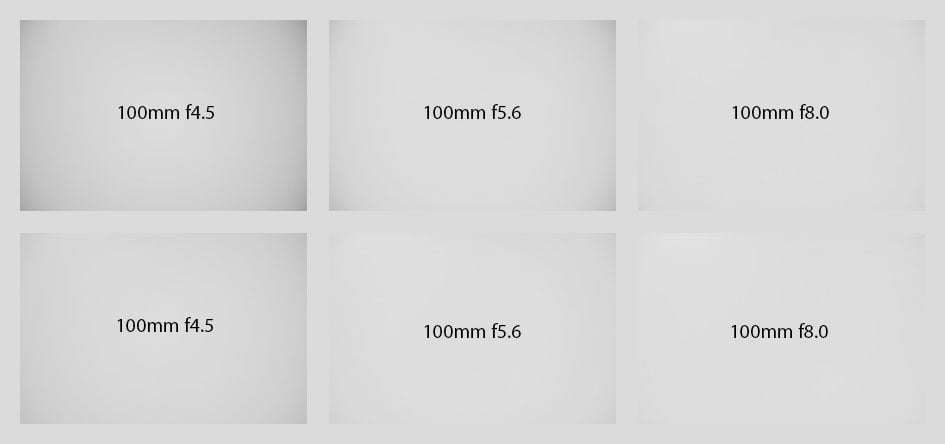
Above: Nikon Z 100-400mm f4.5-5.6 VR S at 100mm focal length
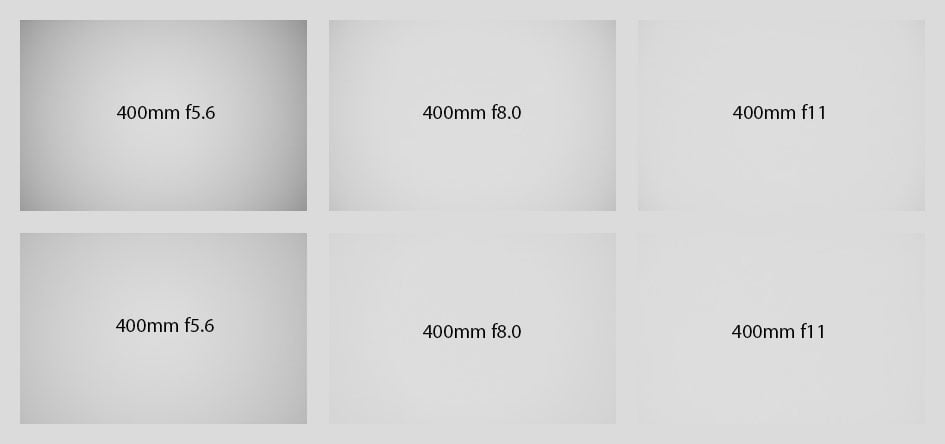
Above: Nikon Z 100-400mm f4.5-5.6 VR S at 400mm focal length
At 100mm vignetting is relatively mild at f4.5 and practically irrelevant from f5.6 onward. At 400mm vignetting is stronger and the sample images above show that even with the lens profile applied it is not completely eliminated at f5.6. With vignette control set to normal the extreme corners are lifted about 0.6 EV when the aperture is wide open. Adobe’s RAW converter automatically applies vignette control as it was set in camera – but you cannot alter the setting in postprocessing.
Distortions show a very slight pin-cushion at 100mm which becomes clearly visible from 200mm focal length onwards. The setting for distortion compensation in camera is currently ignored by Adobe’s RAW converter and treated as ON. The following composite images show a roof rail at the upper border of the full-frame image at various focal lengths first without distortion compensation (JPG) and then with compensation from the built-in lens profile applied to RAW:
Distortions: Nikon Z 100-400mm f4.5-5.6 VR S at 100/200/400mm, auto distortion control Off
Distortions: Nikon Z 100-400mm f4.5-5.6 VR S at 100/200/400mm, auto distortion control On
Distortion compensation through the built-in lens profile works well when applied in camera to JPGs or through Adobe’s RAW converter.
Rendering of point-light sources at night-shots
Night-shots pose a different challenge for lenses as the contrast is even higher than under bright sun and point-light sources can reveal some weaknesses such as coma, haloing and colour-aberrations that do not show up as prominently in other test-shots. The 100% crops below the main image show the effect of coma in the FF-corner of the Nikon Z 100-400mm f4.5-5.6 VR S at different apertures:
Above: Nikon Z 100-400mm f4.5-5.6 VR S at 100mm, f4.5; click image for 4k version, here for large original

Above: Nikon Z 100-400mm f4.5-5.6 VR S at 100mm; 100% crops from the FX-corner at f4.5 (left), f5.6 (middle), f8.0 (right)
The Nikon Z 100-400mm f4.5-5.6 VR S produces very little coma even wide open. The test also shows no color artifacts around bright streetlights.
Bokeh quality
This test is for the rendering of point-light sources in an out-of-focus background. The circle of confusion that is produced by the test is pretty indicative of Bokeh performance (in the background) and light fall-off. Ideally the out-of-focus image of the point-light is evenly lit and perfectly circular, with no “onion-rings”, and without coloration. Large aperture lenses normally produce an effect known as “cat’s eye” the further away from the optical axis the point-light is projected. This is due to optical vignetting in the lens barrel when light enters the lens from an angle.
The crops below the main image are from the center, DX-corner, and FX-corner resized to make them comparable across all my reviews.
Above: Nikon Z 100-400mm f4.5-5.6 VR S at 400mm, f5.6; click image for 4k version
Above: Nikon Z 100-400mm f4.5-5.6 VR S at 400mm, f5.6; click image for 100% crop
Above: Nikon Z 100-400mm f4.5-5.6 VR S at 400mm, f8.0; click image for 100% crop
Above: Nikon Z 100-400mm f4.5-5.6 VR S at 400mm, f11; click image for 100% crop
The diameter of the Bokeh balls in the center is determined by the entrance pupil of the lens which is 71mm at 400mm focal length – the same as for the Nikon Z 70-200mm VR S at 200mm. Compression of the circle towards the corners is relatively strong wide open. The circle of confusion in the center stays round even down to f11. The inside of the Bokeh balls is only lightly textured but there is some outlining – albeit without coloration from loCA.
Let’s see how this analysis of out-of-focus point-light sources translates into Bokeh-performance shooting a book-shelf. Crops are from the foreground, middle-ground, and background resized to make them comparable across all my reviews. I used the longest focal length that I could to produce a comparable shot to my other reviews which was 170mm in the case of the new Z 100-400, 195mm for the Nikon AF-S 80-400mm f4.5-5.6G ED VR, and 165mm for the Nikon Z 70-200mm f2.8 VR S to achieve the same magnification.
Above: Nikon Z 100-400mm f4.5-5.6 VR S at 170mm, f4.8
Above: Nikon Z 100-400mm f4.5-5.6 VR S at 170mm, f4.8; click image for 4k version, here for large original
Above: Nikon AF-S 80-400mm f4.5-5.6G ED VR at 195mm, f5.3; click image for 4k version, here for large original
Above: Nikon Z 70-200mm f2.8 VR S at 165mm, f2.8; click image for 4k version, here for large original
It’s interesting to see that the 1.5 brighter focal ratio of the Z 70-200 (f2.8 vs. f4.8) does not translate into a bigger benefit when it comes to Bokeh. In the middle-ground the Z 70-200 softens up a bit faster but in the background any benefit of the larger aperture is counteracted by some nasty double contours / outlining on fine structures. This can also be seen in another crop (now at 100%) from the same images showing the ruler.
Comparing the Z 100-400 and the F 80-400 show less pronounced differences in the background but in the Z 100-400 produces the softer fore- and middle-ground.
Above: Nikon Z 100-400mm f4.5-5.6 VR S at 170mm, f4.8; click image for 4k version, here for large original
Above: Nikon AF-S 80-400mm f4.5-5.6G ED VR at 195mm, f5.3; click image for 4k version, here for large original
Above: Nikon Z 70-200mm f2.8 VR S at 165mm, f2.8; click image for 4k version, here for large original
Close-up performance
The Nikon Z 100-400mm f4.5-5.6 VR S achieves a pretty decent maximum magnification of around 1:2.5 in close-up shooting at 400mm focal length and 0.68m working distance. The area of sharp focus is just 60 x 90mm. The crops shown below are from 0mm, 14mm, and 19mm off the center of the sensor respectively.

Above: Nikon Z 100-400mm f4.5-5.6 VR S at 400mm, f5.6; 100% crops

Above: Nikon Z 100-400mm f4.5-5.6 VR S at 400mm, f8.0; 100% crops

Above: Nikon Z 100-400mm f4.5-5.6 VR S at 400mm f11; 100% crops
The Nikon Z 100-400mm f4.5-5.6 VR S produces very usable results when stopped down to f8.0 or f11 even in a larger image circle. And there’s almost no field curvature. At lower magnifications the results should even be better.
Flare, ghosting, and sun-stars
Catching a strong light-source shining directly into the lens is always a risky business: it could produce strange colorful ghost-images or reduce contrast considerably through flare and glare. The appearance of flare and ghosting depends on factors like the aperture and the angle of the light hitting the lens. So to judge the proclivity of Nikon’s Z 100-400mm f4.5-5.6 VR S for these artifacts I went through a series of well calculated shots against a strong light source to provoke glare and ghosting. The lens hood was mounted in all shots. Following is one of the more extreme example results. The little bright square inset in the upper left shows the respective area with an exposure compensation of +3 EV to make it easier to see which levels of black the lens renders at that point:
Above: Glare and ghosting from strong light hitting the Nikon Z 100-400mm f4.5-5.6 VR S at 100mm, f11; click image for 4k version or here for +3 EV exposure compensation
Above: Glare and ghosting from strong light hitting the Nikon Z 100-400mm f4.5-5.6 VR S at 100mm, f11; click image for 4k version or here for +3 EV exposure compensation
The Nikon Z 100-400mm f4.5-5.6 VR S shows some ghosting artifacts and suffers a bit from veiling glare when the light-source is inside the frame.
The lens produces relatively weak sunstars even at f11 – a consequence of the well-rounded aperture blades:

Above: Sunstars from the Nikon Z 100-400mm f4.5-5.6 VR S at 100mm, f5.6 (left), f8.0, f11 (right), 100% crops
Next check out my sample images!
Check prices on the Nikon Z 100-400mm f4.5-5.6 at B&H, Adorama, WEX UK or Calumet.de. Alternatively get yourself a copy of my In Camera book or treat me to a coffee! Thanks!
